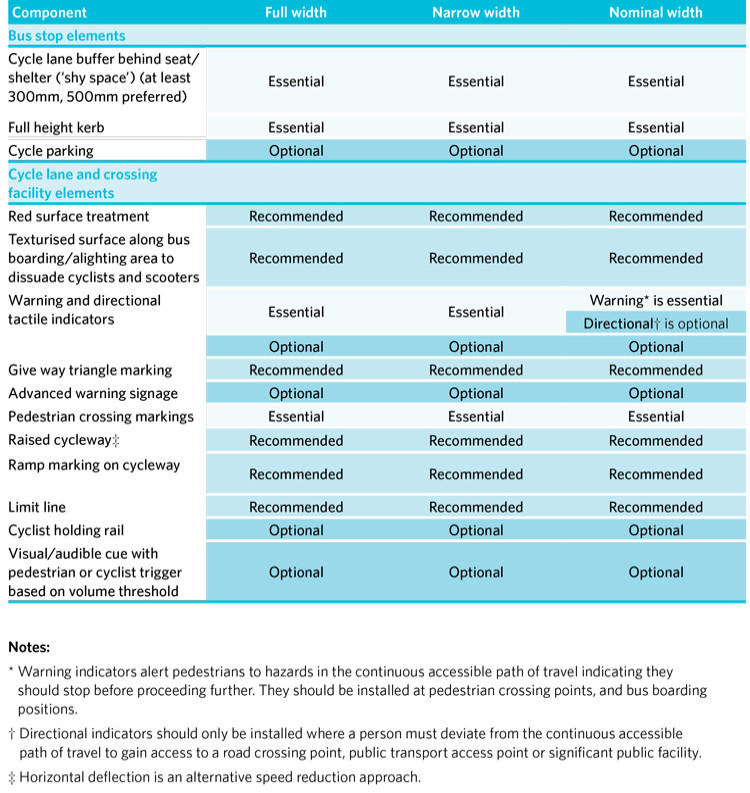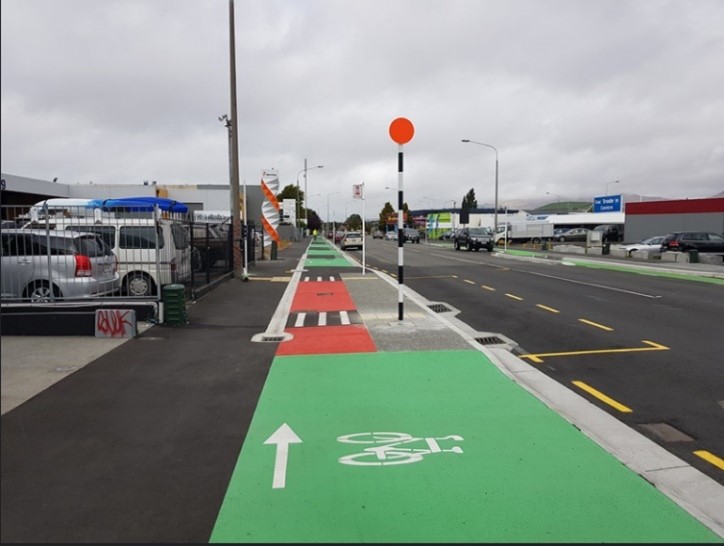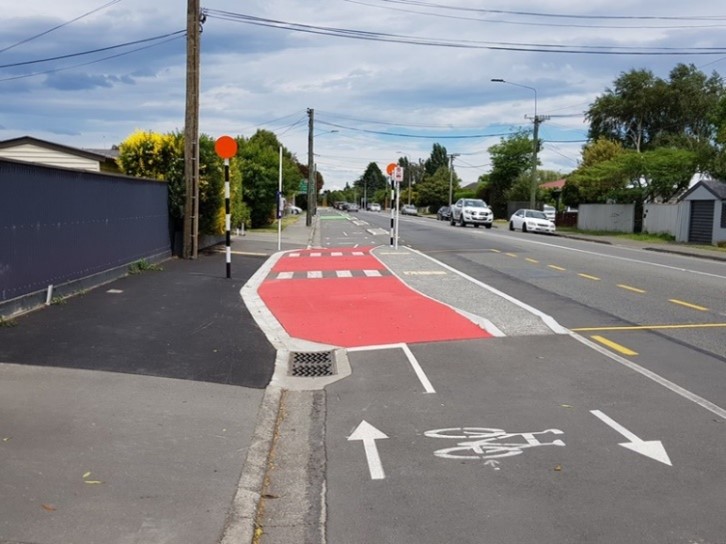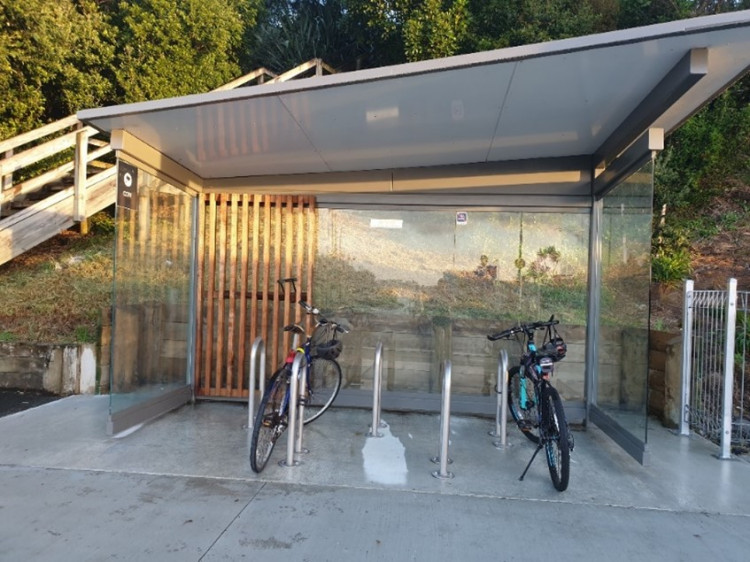More detailed advice on the design components of island bus stops such as ramp markings on cycleways, pedestrian crossing markings, tactile indicators, red surface treatment and more.
The table below outlines the key components specific to the design of island bus stops and whether the component is essential, recommended or optional.
For all other elements at bus stops (for example, accessibility, additional signs and road markings, safety and security, street furniture, stop-specific information and enhancements), see:
Table: Key components of island bus stop design. 
Download key components of island bus stop design table [PDF, 223 KB]
For further information on tactile indicator installation refer to:
Pedestrian Network Guidance: Designing for blind and low vision people
A full-height kerb on the roadside is needed to:
The red surface treatment:

No red surface treatment under the white stripes (one-way cycleway). Note: Belisha beacons are not recommended. (Source: Glen Koorey)

No red surface treatment under the white stripes (two-way cycleway). Note: Belisha beacons are not recommended. (Source: Glen Koorey)
International monitoring studies have found demonstrable benefits to pedestrians of using crossing markings on bus stop bypasses, with no obvious disbenefits to cyclists. For more information, see Transport for London’s:
New cycle infrastructure on London’s streets summary report of on-street trials 2018(external link)
Bus stop bypasses surveys of pedestrians and cyclists 2018(external link)
White stripes marked across the cycleway at the pedestrian crossing indicate that cyclists should yield to pedestrians, even though this crossing is not a legal zebra crossing. A Belisha beacon or fluorescent Belisha beacon disc is not appropriate at such locations because it may cause confusion or impede access for alighting passengers or other footpath users. Moreover, the research cited above found no significant benefit associated with use of Belisha beacons.
Where possible, crossings across a cycleway should have 300mm wide bars with 300mm gaps and a 2m bar length. At least three bars should be painted. On narrow cycleways where three bars cannot fit, 200mm bars with 200mm gaps are acceptable.
Ideally, the crossing point should be positioned to align with the bus doors or at a central crossing point between the footpath and the bus stop island.
Some bus stops have pedestrian crossing markings aligned with the rear door of the bus (see the figures above). However, the differences in bus fleet dimensions across New Zealand affect the rear door placement, whereas the front door of the bus is generally consistent no matter the length of the bus. Therefore, rear door pedestrian crossing markings are considered optional and should be determined based on local bus fleet characteristics, bus frequency, alighting numbers and prominence of cycle route.
If the island bus stop is longer than two bus lengths, it may be impractical to have numerous identified pedestrian crossings. Instead, consider providing additional crossing locations instead of standard pedestrian crossing white line markings and provide behavioural messages such as ‘look left’.
Consider using fencing and other physical separators to direct pedestrians to the crossing points. But consider clearance to the cycleway, as fences could become a hazard for bicycle handlebars.
Use directional tactile ground surface indicators to indicate the location for vision-impaired people to cross the cycleway to access the island bus stop.
On nominal-width islands, directional indicators may be limited to the footpath due to the limited width of the island.
Use warning indicators on each side of the cycleway to alert vision impaired that they are crossing a cycleway.
It is recommended to mark a give way triangle approximately 2m behind the limit line across the cycleway to alert cyclists to give way to people crossing the cycleway. Cyclists are more likely to see this marking than a sign.
Consider use of advance warning signage and measures to convey pedestrian priority such as signage saying ‘cyclists give way to pedestrians’, especially when a facility is new, so as to establish correct behaviour.
Mount any such signage close to eye level of cyclists, but to the side so as to avoid it being a hazard.
As a further aid, especially for visually impaired people, consider using a visual–audible cue with pedestrian or cyclist triggers based on volume thresholds.
Ideally, raise the cycleway to the level of the footpath, so the path of pedestrians remains flat. Although cyclists will experience an uphill change when approaching the bus stop, it can be useful to have the cycleway ramp up just before the crossing point, so that vertical acceleration and having to give way occur at the same point. This also makes the layout easier to read for users.
If the cycleway is already level with the footpath, horizontal deflection is recommended to slow cycling speeds.
Raised cycleways are less important for full-width bus stops, depending on the relative location of the footpath and pedestrian volumes.
Best practice is to have white solid triangle ramp markings on a black surface similar to hump ramp markings as outlined in TCD Part 5 on the approach side of the cycleway ramp marking to provide a clear visual cue for both cyclists and pedestrians.
These markings are not needed on the departure side of a one-way cycleway. When used in cycle lanes and cycle paths, hump ramp marking dimensions may be decreased proportionally as specified in clause 5.4(2A) of the TCD Rule and we would recommend this for optimal conspicuousness of the markings.
Traffic Control Devices Manual Part 5: Vertical deflection device: Markings
We recommend setting the limit line of the cycleway in advance of the pedestrian crossing back about 10m from the front of the bus stop box.
Any hold rails or lean poles should be visible to cyclists. Ideally, differentiate them in some way such as using colour or reflective tape to make them more visible. It should be clear to cyclists that the rails or poles are not for parking a bicycle.
The distance of the hold rails or lean poles from the edge of the cycleway should be convenient for cyclists but not pose a trip hazard for footpath users.
A cycle network to, from or near bus stops can increase the catchment area of the bus service. Where this is the case, consider providing cycle parking at the bus stop.
Key planning principles for cycle parking are that parks should:

Cycle parking at a bus stop, Auckland. (Source: Flow Transportation Specialists)
For more guidance on designing for cycle and/or micromobility parking, see: